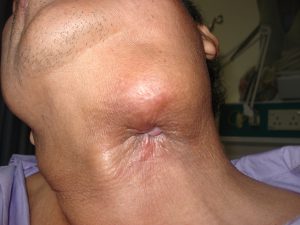Neck Mass In Adult
Neck mass that is persisted longer than 2 weeks should be investigated and medical personnel should be consulted. Neck mass in adult should be treated carefully as it might be due to malignancy. Nasopharyngeal carcinoma is the commonest cancer that spread to the neck among our local community especially among the chinese ethnicity and then followed by the malay community. Other cancer that could spread to neck would be tongue cancer, oral cavity cancer, tonsil cancer, oropharyngeal cancer, hypo pharyngeal cancer, laryngeal cancer and any other head and neck cancer. Malignancy is a concern in thyroid mass patient especially when it is associated with cervical lymph node enlargement. Lymphoma, sarcoma and salivary gland tumour might also present as a neck mass. Very rarely the tumour could spread from other part of the body to the lymph node in the neck.

Tumour eroding from submandibular lymph node and cause ulceration over the skin
Cervical lymph nodes enlargement in adult have a great proportion of it is due to mycobacterium tuberculosis in comparison with children as the exposure is higher in adult. Other cause of cervical lymphadenopathy are viral or bacteria infection, cat scratch disease and granulomatous lesion. Lymphadenitis might progress to become neck abscess which might require incision and drainage.
Congenital mass such as branchial cleft cyst, thyroglossal duct cyst, cystic hygroma and dermoid cyst might also present in adulthood.
Other benign lesion over the neck include carotid body tumour, schwannoma, thyroid tumour, lipoma, hemangioma, fibroma and neuroma.
Nasal cavity, nasopharynx, oropharynx, hypopharynx and larynx should be examined via flexible nasa-pharyngolaryngoscope to exclude any malignancies that might metastasized to the lymph nodes in the neck. If any mass noted during the examination, biopsy should be taken to rule out malignancy.
Blood test, mantoux test and fine-needle aspiration are usually done to determine the cause of the mass. If the investigations failed to harvest any result and if FNAC are inconclusive for TB and no carcinoma seen, then incisional or excision biopsy should be done. Contrast-enhanced computed tomographic (CT) scanning is recommended to evaluate these masses.
Diagnosis of cervical mass is very crucial before embark on the surgical excision. Medical therapy is the main stream of treatment if the cause of the mass is due to infection or inflammation except cervical abscess which might require incision and drainage. Benign and congenital lesions usually could be safely excised except vascular malformation or very vascular tumour where embolisation might be needed before the surgical excision to reduce the bleeding intraoperatively. If the cervical lymph node is due to malignancy, then the primary cancer should be ascertain and treatment is all depend on the types of the primary tumour.
Nasopharyngeal carcinoma usually is treated with chemo-radiotherapy. In hypopharyngeal and oropharyngeal cancer, radiotherapy might be an option or alternative to surgery. In early laryngeal carcinoma, radiotherapy and surgery offer an equal chance or cure. However, oral cavity and tongue cancer should be treated with excision of the primary and neck lesion whenever the patient is fit for operation.